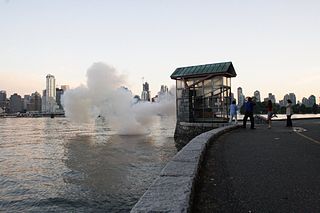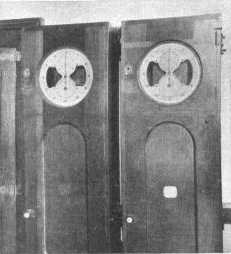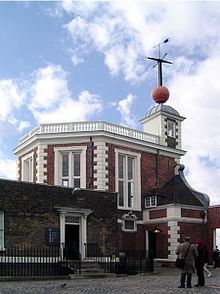
Greenwich Mean Time (GMT) is the local mean time at the Royal Observatory in Greenwich, London, counted from midnight. At different times in the past, it has been calculated in different ways, including being calculated from noon; as a consequence, it cannot be used to specify a particular time unless a context is given. The term GMT is also used as one of the names for the time zone UTC+00:00 and, in UK law, is the basis for civil time in the United Kingdom.
A time standard is a specification for measuring time: either the rate at which time passes or points in time or both. In modern times, several time specifications have been officially recognized as standards, where formerly they were matters of custom and practice. An example of a kind of time standard can be a time scale, specifying a method for measuring divisions of time. A standard for civil time can specify both time intervals and time-of-day.
Universal Time is a time standard based on Earth's rotation. While originally it was mean solar time at 0° longitude, precise measurements of the Sun are difficult. Therefore, UT1 is computed from a measure of the Earth's angle with respect to the International Celestial Reference Frame (ICRF), called the Earth Rotation Angle. UT1 is the same everywhere on Earth. UT1 is required to follow the relationship

The United States Naval Observatory (USNO) is a scientific and military facility that produces geopositioning, navigation and timekeeping data for the United States Navy and the United States Department of Defense. Established in 1830 as the Depot of Charts and Instruments, it is one of the oldest scientific agencies in the United States, and remains the country's leading authority for astronomical and timing data for all purposes.

The Royal Observatory, Greenwich is an observatory situated on a hill in Greenwich Park in south east London, overlooking the River Thames to the north. It played a major role in the history of astronomy and navigation, and because the Prime Meridian passed through it, it gave its name to Greenwich Mean Time, the precursor to today's Coordinated Universal Time (UTC). The ROG has the IAU observatory code of 000, the first in the list. ROG, the National Maritime Museum, the Queen's House and the clipper ship Cutty Sark are collectively designated Royal Museums Greenwich.

A radio clock or radio-controlled clock (RCC), and often colloquially referred to as an "atomic clock", is a type of quartz clock or watch that is automatically synchronized to a time code transmitted by a radio transmitter connected to a time standard such as an atomic clock. Such a clock may be synchronized to the time sent by a single transmitter, such as many national or regional time transmitters, or may use the multiple transmitters used by satellite navigation systems such as Global Positioning System. Such systems may be used to automatically set clocks or for any purpose where accurate time is needed. Radio clocks may include any feature available for a clock, such as alarm function, display of ambient temperature and humidity, broadcast radio reception, etc.
The Greenwich Time Signal (GTS), popularly known as the pips, is a series of six short tones broadcast at one-second intervals by many BBC Radio stations. The pips were introduced in 1924 and have been generated by the BBC since 1990 to mark the precise start of each hour. Their utility in calibration is diminishing as digital broadcasting entails time lags.
CHU is the call sign of a shortwave time signal radio station operated by the Institute for National Measurement Standards of the National Research Council. CHU's signal is used for continuous dissemination of official Canadian government time signals, derived from atomic clocks.

DCF77 is a German longwave time signal and standard-frequency radio station. It started service as a standard-frequency station on 1 January 1959. In June 1973 date and time information was added. Its primary and backup transmitter are located at 50°0′56″N9°00′39″E in Mainflingen, about 25 km south-east of Frankfurt am Main, Germany. The transmitter generates a nominal power of 50 kW, of which about 30 to 35 kW can be radiated via a T-antenna.

The National Research Council Time Signal was Canada's longest running radio program, begun 5 November 1939 until its final broadcast on 9 October 2023. Broadcast daily shortly before 13:00 Eastern Time across the CBC Radio One network, it lasted between 15 and 60 seconds, ending exactly at 13:00. During standard time, the signal was at 13:00 Eastern Standard Time and during Daylight Saving Time, the signal was at 13:00 Eastern Daylight Saving Time.

A time ball or timeball is a time-signalling device. It consists of a large, painted wooden or metal ball that is dropped at a predetermined time, principally to enable navigators aboard ships offshore to verify the setting of their marine chronometers. Accurate timekeeping is essential to the determination of longitude at sea.

The Noon Gun has been a historic time signal in Cape Town, South Africa since 1806. It consists of a pair of black powder Dutch naval guns, fired alternatingly with one serving as a backup. The guns are situated on Signal Hill, close to the centre of the city.

Ladd Observatory is an astronomical observatory at Brown University in Providence, Rhode Island. Founded in 1891 it was primarily designed for student instruction and also research. The facility operated a regional timekeeping service. It was responsible for the care and calibration of clocks on campus including one at Carrie Tower and another that rang the class bell at University Hall. Meteorological observations were made there from the time the building opened using recording weather instruments.

A clock network or clock system is a set of synchronized clocks designed to always show exactly the same time by communicating with each other. Clock networks usually consist of a central master clock kept in sync with an official time source, and one or more slave clocks which receive and display the time from the master.

The 9 O'Clock Gun is a cannon located in Vancouver, British Columbia, Canada, that is ordinarily fired daily at 21:00 (9 p.m.) PT.

A master clock is a precision clock that provides timing signals to synchronise slave clocks as part of a clock network. Networks of electric clocks connected by wires to a precision master pendulum clock began to be used in institutions like factories, offices, and schools around 1900. Modern radio clocks are synchronised by radio signals or Internet connections to a worldwide time system called Coordinated Universal Time (UTC), which is governed by primary reference atomic clocks in many countries.

The Shepherd Gate Clock is mounted on the wall outside the gate of the Royal Observatory, Greenwich building in Greenwich, Greater London. The clock, an early example of an electrically connected clock system, was a sympathetic clock mechanism controlled by electric pulses transmitted by a motor clock inside the main building. The network of 'sympathetic clocks' was constructed and installed by Charles Shepherd in 1852. The clock by the gate was probably the first to display Greenwich Mean Time to the public, and is unusual in using the 24-hour analog dial. Also, it originally showed astronomical time which started at 12 noon, not midnight.

A marine chronometer is a precision timepiece that is carried on a ship and employed in the determination of the ship's position by celestial navigation. It is used to determine longitude by comparing Greenwich Mean Time (GMT), and the time at the current location found from observations of celestial bodies. When first developed in the 18th century, it was a major technical achievement, as accurate knowledge of the time over a long sea voyage was vital for effective navigation, lacking electronic or communications aids. The first true chronometer was the life work of one man, John Harrison, spanning 31 years of persistent experimentation and testing that revolutionized naval navigation.

The history of longitude describes the centuries-long effort by astronomers, cartographers and navigators to discover a means of determining the longitude of any given place on Earth. The measurement of longitude is important to both cartography and navigation. In particular, for safe ocean navigation, knowledge of both latitude and longitude is required, however latitude can be determined with good accuracy with local astronomical observations.
The Port Chalmers time ball is a Victorian maritime Greenwich Mean Time signal located on Aurora Terrace on top of Observation Point in the port of Port Chalmers, New Zealand. It was established in 1867 by the Otago Provincial Council. The time ball fell precisely at 1 p.m. daily. Originally triggered by a grandfather clock, from 1882 onwards a telegraph signal from Wellington took over this function. It was removed in 1970, but a replacement was restored to service in 2020.




















